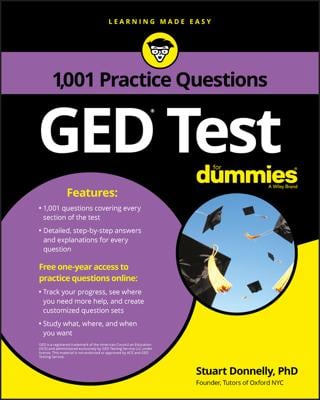You can increase your GED score by practicing smart exam-taking. This article gives you some tips for planning your time, guessing intelligently, and reviewing your work.
Watching the clock
When the test begins, check your watch and write down the time you start and the time that you'll finish. (Write this near the top of your answer sheet in very light pencil marks that you erase before handing it in.) This way, you don't have to waste time figuring out how much time you have left partway through the test. Don't try to remember the time; instead, write it down.
During the test, you'll probably be warned — perhaps more than once — about how much time remains. Check what you're told against the time you write down.
Table 1 shows you how much time you have, on average, for each question.
Table 1: Time Per Question for Each GED Test
Test | Questions | Time Limit (in Minutes) | Time per Question (in Minutes) |
Language Arts, Writing, Part I | 50 | 75 | 1.5 |
Language Arts, Writing, Part II | 1 essay | 45 | 45 |
Social Studies | 50 | 70 | 1.4 |
Science | 50 | 80 | 1.6 |
Language Arts, Reading | 40 | 65 | 1.6 |
Mathematics, Parts I and II | 50 | 90 | 1.8 |
Keep in mind that if you take two minutes for each question, you won't complete all the answers on the test.
Time a bunch of questions as a group, for example, spending 15 minutes on each group of 10 questions.
Guess for success: Using intelligent guessing strategies
The multiple-choice questions provide you with five possible answers: You get one point for a correct answer, and nothing is subtracted for an incorrect answer. Because you aren't penalized for guessing, you want to guess logically by eliminating as many wrong choices as possible and choosing from just one or two.
When the question gives you five possible answers and you randomly choose one, you have a 20 percent chance of guessing the correct answer without even reading the question. This is not a recommended strategy, of course.
However, if you know that one of the answers is definitely wrong, you now have just four answers to chose from and have a 25 percent chance (1 in 4) of choosing the correct answer. If you know that two of the answers are wrong, that leaves 3 possible answers to chose from, giving you a 33 percent (1 in 3) chance—much better than 20 percent! You now have a 1 in 3 or 33% chance of getting the right answer by guessing. And finally, if you know that three of the answers are wrong, your chances of choosing the correct answer move up to 50 percent. That's as good as a random choice gets!
So, if you don't know the answer, you need to know how to spot wrong choices:
- Wrong choices usually don't answer the question; that is, they may sound good, but they're answering a different question.
- Sometimes, two answers are very close. Consider both of these for future consideration, because they both can't be right, but both can be wrong. Answers that are very close are sometimes given to see if you really know the answer.
- Look for opposite answers in the hopes that you can eliminate one. Both answers can't be right, but both can be wrong.
- Some wrong choices may just strike you as wrong when you first read them. Trust your instincts. If you spent time preparing for these exams, you have probably learned more than you think.
Leaving time for review
Try to finish a few minutes early in order to review questions, especially those that you're unsure about. Allowing extra time at the end also keeps you from scrambling at the very end.
In answering multiple-choice questions, the answer you think is correct usually is. Don't change an answer unless you're sure that it's wrong. If you're positive, make sure you completely erase your original answer.
GED tests are scored by machines (except the essay in the Language Arts, Writing, Part II test). If the machine believes you've marked two answers, neither one counts. If you ever change an answer, be sure to completely erase the original answer before you turn in your test.
In order to leave time for review at the end of the test, you have to spend less time on each question than Table 1 suggested. Table 2 suggests a way to allow time for review.
Table 2: Time Per Question Plus Time for Review
Test | Questions | Time Limit (in Minutes) | Time per Question (in Minutes) | Time for Review (in Minutes) |
Language Arts, Writing, Part I | 50 | 75 | 1.2 | 10 |
Language Arts, Writing, Part II | 1 essay | 45 | 30 | 15 |
Social Studies | 50 | 70 | 1.2 | 10 |
Science | 50 | 80 | 1.4 | 10 |
Language Arts, Reading | 40 | 65 | 1.4 | 10 |
Mathematics, Parts I and II | 50 | 90 | 1.5 | 15 |
If you use your review time wisely, you may be able to improve your score. But you can't panic: The worst thing you can do is to panic and change answers with no reason.

